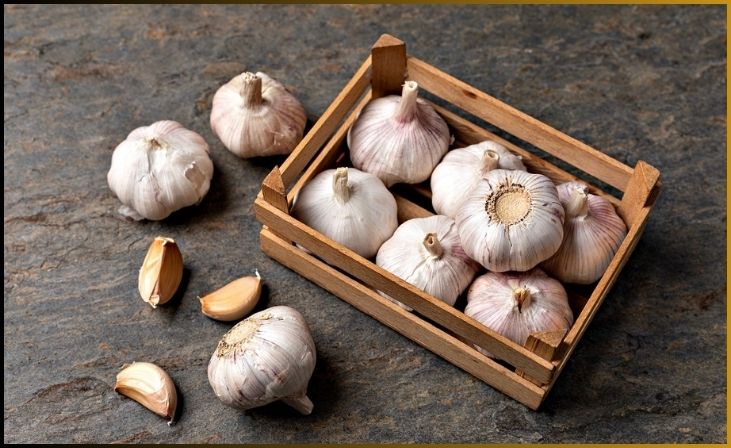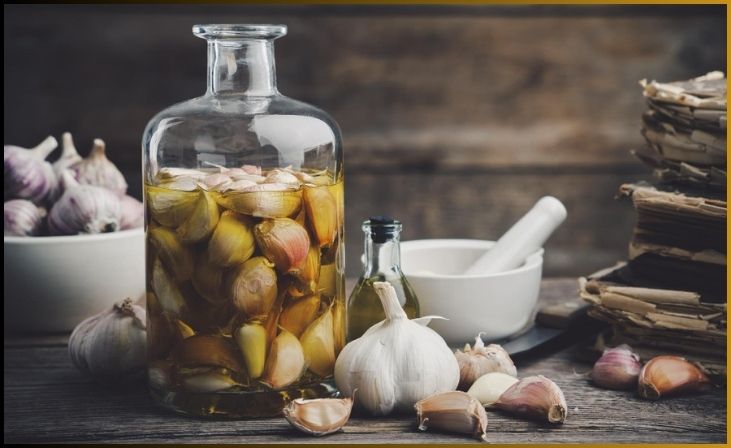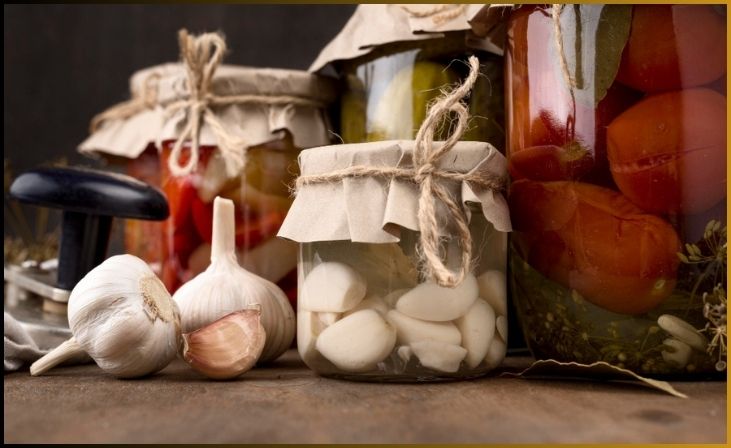In the realm of culinary exploration, the process of fermenting garlic unfolds as a captivating journey that transforms this kitchen staple into a flavor-rich, probiotic powerhouse. From its humble origins as a pungent bulb, garlic takes on new dimensions through fermentation, offering not only a milder taste but also a wealth of health benefits.
In this blog, we embark on an aromatic adventure into the art of fermenting garlic – uncovering the steps, exploring creative recipes, and delving into the transformative changes that make fermented garlic a culinary gem. Join us as we peel back the layers of cloves and discover how this age-old preservation method can turn ordinary garlic into an extraordinary, versatile delight.
Table of Contents
ToggleThe Basics of Garlic Fermentation:
1. Choosing the Right Garlic:

Selecting the right garlic is the foundational step in the fermentation process. Opt for fresh, high-quality garlic bulbs sourced from a reputable supplier or your own garden. Choosing organic garlic is advisable to avoid exposure to pesticides and chemicals. Look for bulbs that are plump, firm, and free from signs of decay. Larger cloves often yield better results, providing a robust foundation for fermentation. Ensuring the quality of the garlic sets the stage for a successful fermentation, allowing the cloves to develop complex flavors and beneficial compounds during the fermentation journey.
Also Read- 4 Tips for Fermenting Fruit Successfully
2. Preparing the Garlic:
Preparing the garlic is a crucial step in the fermentation process. Start by separating the cloves from the bulb and leaving the skin intact to protect them during fermentation. Gently crush each clove with the flat side of a knife, releasing natural oils and enzymes that enhance flavor development. Crushing the garlic initiates the enzymatic processes that contribute to the unique taste of fermented garlic. This step not only facilitates the release of aromatic compounds but also ensures that the garlic is primed for the fermentation journey, where it will undergo transformative changes in both flavor and texture.
3. Creating the Brine:
Creating the brine is a fundamental aspect of fermenting garlic. This simple solution acts as a preservative and provides the necessary environment for beneficial lactic acid bacteria to thrive. To make the brine, dissolve non-iodized salt in water, using approximately 2-3% salt by weight of the water. This ensures an optimal salt concentration for fermentation. The brine helps prevent the growth of harmful microorganisms while allowing the garlic to undergo the transformative process of fermentation. Maintaining the right balance in the brine sets the stage for a successful and flavorful fermentation journey for the garlic cloves.
The Fermentation Process:
1. Packing the Jars:

Packing the jars is a pivotal step in the garlic fermentation process. Once the garlic cloves are prepared, they are placed into clean, sterilized jars, leaving some headspace. It’s crucial to ensure that the garlic is fully submerged in the brine, creating an anaerobic environment that inhibits the growth of harmful microorganisms.
This step not only safeguards the garlic during fermentation but also allows the cloves to develop their unique flavors. Consider adding herbs, spices, or additional flavorings at this stage to impart extra layers of complexity to the fermented garlic. Properly packing the jars sets the foundation for a successful fermentation, where the garlic undergoes a transformative journey into a flavorful and probiotic-rich delicacy.
2. Weighting Down the Garlic:
Weighting down the garlic is a crucial practice in garlic fermentation. After packing the prepared garlic cloves into jars, it’s essential to ensure they remain fully submerged in the brine during the fermentation process. This prevents exposure to oxygen, reducing the risk of spoilage and mold growth. To achieve this, fermentation weights or sterilized stones are placed on top of the garlic to keep it beneath the liquid’s surface.
This step guarantees an anaerobic environment, allowing beneficial lactic acid bacteria to flourish and initiate the fermentation process. Properly weighting down the garlic is a key measure in maintaining a successful and contamination-free fermentation, resulting in flavorful and well-preserved cloves.
3. Allowing Fermentation Time:
Allowing fermentation time is a patient and crucial stage in the process of fermenting garlic. After packing the jars and ensuring the garlic is fully submerged, they are placed in a dark, room-temperature environment. The duration of fermentation varies but generally takes around 3 to 4 weeks. During this time, beneficial microorganisms, particularly lactic acid bacteria, work their magic on the garlic, transforming its flavors and textures.
Regularly check the garlic, tasting it periodically to gauge the progression and stop the fermentation when the desired flavor is achieved. Allowing adequate time for fermentation is key to unlocking the full potential of the garlic’s taste, turning it into a complex and probiotic-rich culinary delight.
4. Storing Fermented Garlic:
Storing fermented garlic is the final step in the process, ensuring that the flavors developed during fermentation are preserved over time. Once the fermentation period is complete, move the jars to the refrigerator to slow down the process. The cool temperature inhibits further fermentation while allowing the flavors to mature. Fermented garlic can be stored in the refrigerator for several months.
The extended storage not only maintains the garlic’s probiotic properties but also allows its taste to evolve, resulting in a well-rounded and nuanced final product. Proper storage ensures that your fermented garlic remains a versatile and flavorful addition to various culinary creations.
Creative Fermented Garlic Recipes:
1. Honey and Garlic Fermentation:
Honey and garlic fermentation combines the savory richness of garlic with the sweetness of honey, resulting in a delectable and versatile concoction. To create this infusion, start by preparing garlic cloves as usual, leaving the skin on. Place the cloves in a jar and cover them with honey, ensuring they are fully submerged. The natural sugars in honey act as a source of food for fermentation, while its antimicrobial properties contribute to the preservation process.
Don't just scroll, subscribe!
BuzzTrail's unique web-stories are the cure for boredom you've been waiting for.
Allow the honey and garlic mixture to ferment in a dark, room-temperature environment for a few weeks. The end result is a harmonious blend of sweet and savory notes, perfect for spreading on toast, drizzling over cheese, or incorporating into marinades for a delightful culinary experience. Experiment with ratios to find the perfect balance that suits your taste preferences.
2. Fermented Garlic Hot Sauce:
Crafting fermented garlic hot sauce is an exciting way to elevate your culinary creations with a kick of heat and rich, complex flavors. To embark on this flavorful journey, start by fermenting garlic cloves alongside your favorite chili peppers. Crushed garlic cloves, combined with the fiery punch of chili peppers, create a dynamic base for your hot sauce. Pack the mixture into jars, ensuring the ingredients are fully submerged in a brine solution. Allow the magic of fermentation to unfold over a few weeks in a dark, room-temperature environment.
Once the fermentation process is complete, blend the mixture to your desired consistency, creating a homemade hot sauce that balances the robust flavors of fermented garlic with the heat of chili peppers. Versatile and full of character, this fermented garlic hot sauce is an excellent addition to tacos, grilled meats, or any dish that craves a flavorful and spicy boost. Experiment with pepper varieties to customize the heat level according to your preferences.
3. Fermented Garlic Pickles:

Fermented garlic pickles offer a delightful twist on traditional pickles, infusing the tangy crunch of pickled cucumbers with the rich flavors of fermented garlic. To create these zesty treats, start by preparing garlic cloves and cucumbers. Combine them in a jar along with dill, spices, and a brine solution. The fermentation process transforms this medley into a symphony of flavors, resulting in pickles that are not only crunchy but also carry the distinct taste of fermented garlic.
Allow the jar to ferment in a cool, dark place for a few weeks, tasting periodically to achieve the desired flavor. The end result is a jar of fermented garlic pickles that adds a burst of tanginess and complexity to salads, sandwiches, or enjoyed on their own as a flavorful and probiotic-rich snack. Experiment with spice levels and additional herbs to tailor the pickles to your taste preferences.
4. Garlic and Herb Fermentation:
Garlic and herb fermentation is a culinary adventure that enhances the natural richness of garlic by introducing a medley of fresh herbs. To embark on this flavorful journey, begin by preparing garlic cloves and selecting a variety of herbs such as rosemary, thyme, and oregano. Pack the combination into clean jars, ensuring the garlic is fully submerged in a brine solution.
The fermentation process allows the garlic to absorb the aromatic essence of the herbs, resulting in a complex and versatile condiment. After a few weeks of fermentation in a dark, room-temperature environment, the garlic and herb mixture evolves into a flavorful infusion. Use this aromatic creation to elevate the taste of meats, vegetables, or as a savory addition to dips and spreads. Experiment with different herb combinations to tailor the fermented garlic and herb infusion to your culinary preferences.
Health Benefits of Fermented Garlic:

1. Enhanced Nutrient Bioavailability:
Enhanced nutrient bioavailability is a significant benefit of fermenting garlic. Through the fermentation process, compounds in garlic undergo transformation, breaking down barriers that may inhibit nutrient absorption. One of the key compounds affected is allicin, renowned for its antibacterial and antifungal properties. Fermentation enhances the bioavailability of essential nutrients, making them more accessible for absorption in the digestive system.
As a result, the probiotic-rich fermented garlic becomes a nutritional powerhouse, offering improved absorption of beneficial compounds. Including fermented garlic in your diet not only introduces a unique and milder flavor but also maximizes the potential health benefits derived from this ancient culinary technique.
2. Probiotic Powerhouse:
Fermented garlic emerges as a probiotic powerhouse, teeming with beneficial bacteria that promote a healthy gut microbiome. The fermentation process encourages the growth of lactic acid bacteria, known for their positive impact on digestive health and overall well-being. As these beneficial microorganisms proliferate during fermentation, they contribute to the development of probiotics in the garlic.
Incorporating fermented garlic into your diet introduces these probiotics, supporting digestion, bolstering the immune system, and potentially influencing mood regulation. Embrace the probiotic powerhouse of fermented garlic as a flavorful addition to your culinary repertoire, promoting not only taste but also the well-being of your gut.
For More- How to Make Fermented Salsa: A Flavorful Twist on a Classic
3. Reduced Pungency:
Fermentation brings about a notable transformation in garlic, offering a palate-friendly alternative by reducing its pungency. The strong and sometimes overpowering flavor of raw garlic is mellowed through the fermentation process, resulting in a more nuanced and mild taste. This reduction in pungency makes fermented garlic an appealing option for those sensitive to the sharpness of raw cloves.
The outcome is a versatile ingredient that retains the essence of garlic but in a gentler form, allowing it to complement a wide array of dishes without overwhelming the taste buds. Embracing fermented garlic not only broadens culinary possibilities but also offers a more approachable and palatable garlic experience.
Conclusion
Fermenting garlic is a rewarding culinary adventure that not only transforms the familiar bulb into a complex, probiotic-rich delight but also opens the door to a myriad of creative possibilities. By mastering the basics, experimenting with flavors, and understanding the health benefits, you can elevate your culinary skills and embark on a journey through the world of fermented garlic. Whether enjoyed on its own or incorporated into diverse recipes, fermented garlic is a testament to the alchemical wonders that unfold when traditional preservation meets modern gastronomy. So, roll up your sleeves, gather your garlic, and let the fermentation magic begin!
FAQs
Can I use store-bought garlic for fermentation?
Can I use store-bought garlic for fermentation?
Yes, store-bought garlic can be used for fermentation. Ensure it is fresh, free from sprouts, and preferably organic to avoid unwanted chemicals. High-quality garlic varieties, often found in specialty stores, can yield excellent results.
How do I know if my fermented garlic has gone bad?
How do I know if my fermented garlic has gone bad?
Signs of spoilage include off-putting odors, mold growth, or drastic changes in color. If your fermented garlic exhibits any of these signs, it’s best to discard the batch to avoid consuming spoiled food.
Can I use garlic that has started sprouting?
Can I use garlic that has started sprouting?
While sprouting garlic cloves can be used, it’s advisable to remove the sprouts as they can contribute bitterness to the final product. Choose cloves that are firm and free from mold or signs of decay.

